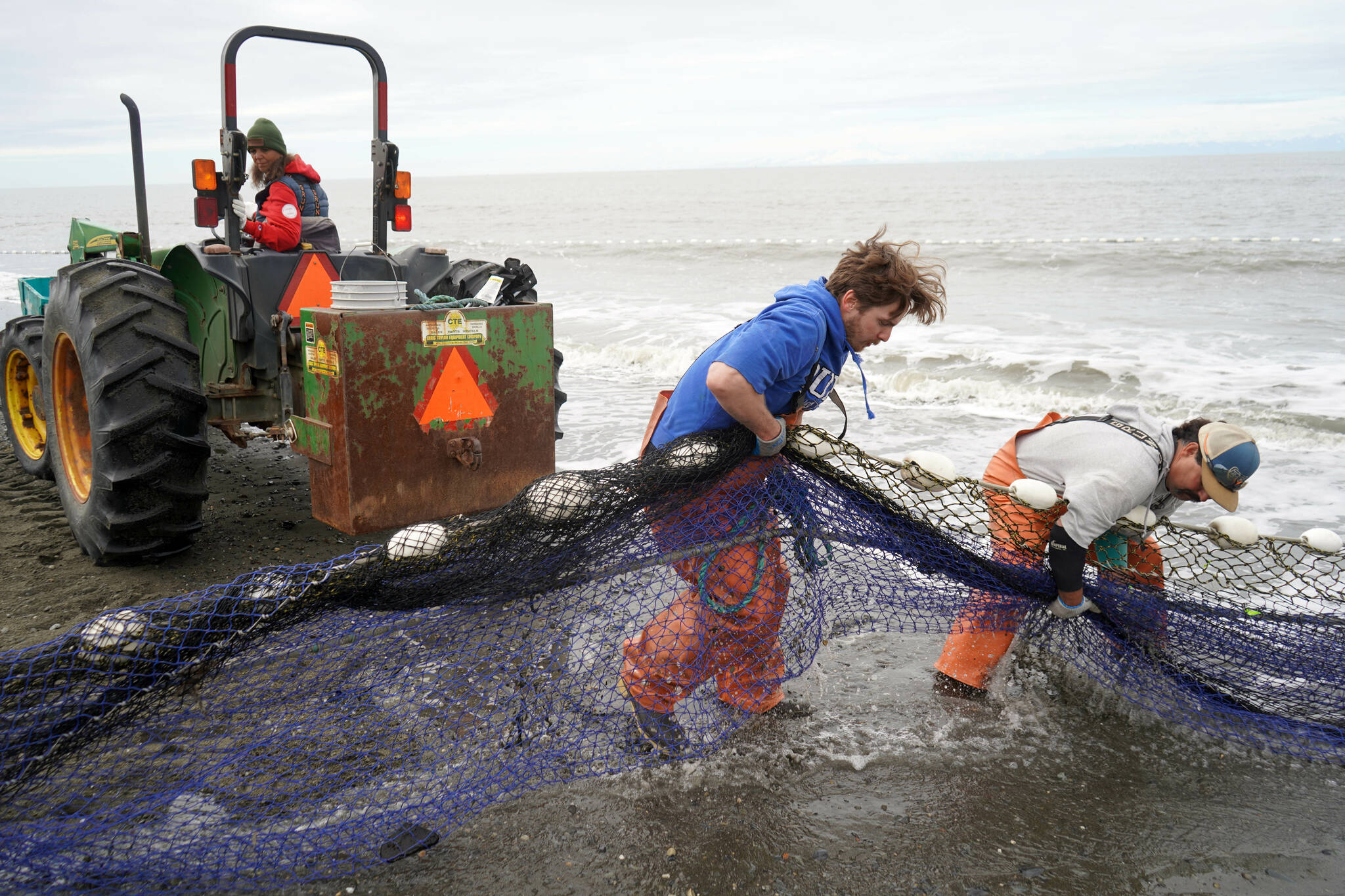The State Board of Fisheries will in March consider the use of beach seines as an alternative gear type for the east side setnet fishery.
The board on Wednesday, Oct. 30, accepted an agenda change request penned by Brian and Lisa Gabriel — ACR 8 in this year’s work session agenda. A proposal based on that request will be considered during the board’s meeting on “Statewide Shellfish, Prince William Sound Shrimp, and Supplemental Issues,” scheduled to run from March 11-16 in Anchorage at the Egan Civic and Convention Center.
This summer, the Gabriels led a test fishery operated under a commissioner’s permit to explore beach seines as an option to harvest target sockeye salmon without killing king salmon. They told the Clarion in July that they’d seen their nets work successfully — that they hadn’t killed a king salmon, that they could adapt the nets to different sites, and that they’d caught enough sockeye to be economically viable.
Their request is for the use of set beach seine nets as a gear type in the east side setnet fishery. Their proposal describes a fishing season from June 20 to Aug. 15, with the use of one set beach seine net per permit, used with shore-based infrastructure. The nets may be up to 100 fathoms in length, 215 mesh deep with a maximum mesh size of 3-and-a-half inches. If gillnet fishing were allowed by regulation, a permit holder would have to fish one or the other.
“The method has now been proven as a successful ethical harvest method of sockeye salmon while successfully releasing all king salmon in excellent condition during times of king salmon conservation,” they write in the request. “The set beach seine net worked on many beaches and fishermen will be able to use their existing lead lines, cork lines, corks, and infrastructure to prosecute the fishery without substantial expense.”
An assessment of the request by the State Department of Fish and Game found that the request addresses an effect on a fishery unforeseen when a regulation was adopted. Specifically, the department said Wednesday that when the east side setnet fishery was closed by the Kenai River late-run king salmon stock of concern management plan, the board encouraged users to “explore other potential methods through a commissioner’s permit.”
The outcome of this summer’s test, they said, represents new information.
Member Mike Wood, of Talkeetna, said he’s very interested in seeing fishers think “outside of the box” to find means of harvesting sockeye salmon without killing king salmon. He said he wanted to see the seines discussed further in March.
Seining, Wood said, is “pretty hardcore — harder than setnetting.”
“This is definitely new information,” member Curtis Chamberlain, of Anchorage, said. “It’s very exciting.”
Tom Carpenter said the study represents “a lot” of new information. He cited a report compiled by Robert Begich, submitted to the work session meeting notes by Lisa Gabriel, as illustrative of the willingness and ability of the Gabriels to provide the information they need to consider in discussing the seines.
That report, the “Experimental Set Beach Seine Fishery Report,” describes the Gabriel’s efforts under the commissioner’s permit. It says that to prove the set beach seines could work in Upper Cook Inlet while king salmon remain a stock of management concern, they had to answer six questions.
Existing setnet infrastructure can support 600 foot set beach seines, Begich wrote, and that infrastructure can be easily and affordably converted for that purpose. The seines can successfully harvest sockeye while releasing king salmon in viable condition. They can harvest enough sockeye to be economically viable. The seines can be adapted to different beaches and used within existing leased and traditionally fished locations.
In testing the nets, they fished multiple different lengths depths and weights of gear. They measured the movement of the net and measured efficacy by the number of salmon captures divided by the number of minutes of hold time — the difference between when the net was deployed and when the net began to be withdrawn.
In the first of two tests, 15,513 salmon were captured. Only one large king salmon was captured, alongside 12 other small king salmon, and all were released “alive in viable unharmed condition.” That capture was completed with nearly 43 hours of hold time — when the nets were deployed — and higher efficiency was observed in the ebb tide.
At a second test, 5,228 sockeye salmon were caught to only three small kings.
“Set beach seine fishing in the area traditionally fished with set gillnet gear was successful at eliminating mortality of king salmon,” the report reads. “On all tested locations, it was shown that sockeye salmon can be harvested at an economically viable level while releasing all king salmon in a healthy condition.”
The seines are thought not to be able to reach the same harvest level as a fully operational setnet fishery, the report says, but “it is the consensus of the testers” that beach seines should be allowed to harvest sockeye in times of king salmon conservation.
The board supported the request unanimously. With the request accepted, the department will generate a proposal to be considered at the March meeting.
A full recording of the Board of Fisheries work session, and the full set beach seine report by Robert Begich can be found at adfg.alaska.gov.
This story was edited on Tuesday, Nov. 5, to correct the authorship of the set beach seine fishery report — which Robert Begich wrote. A previous version of the story attributed the report to Lisa Gabriel.
Reach reporter Jake Dye at jacob.dye@peninsulaclarion.com.

